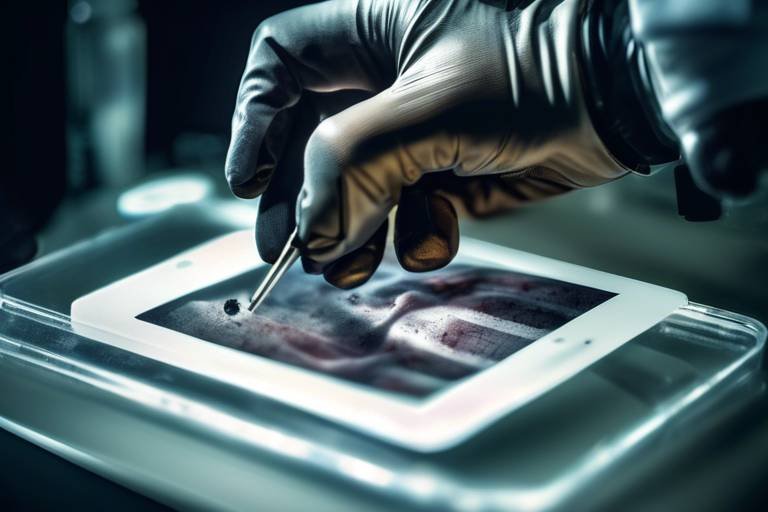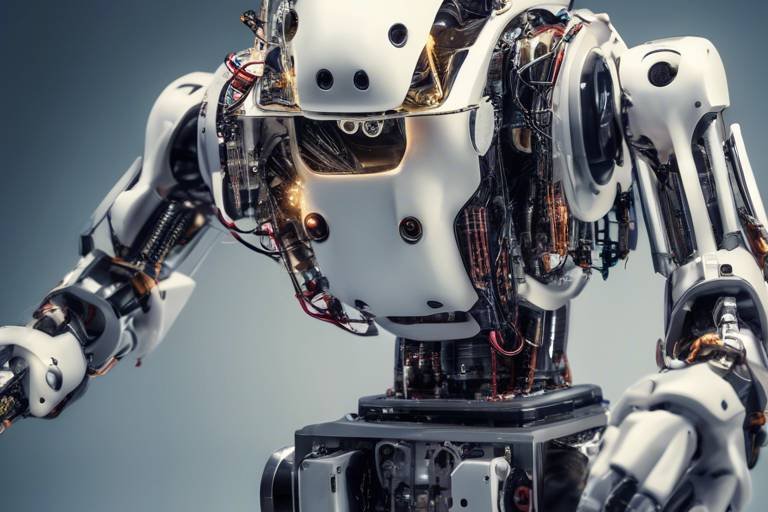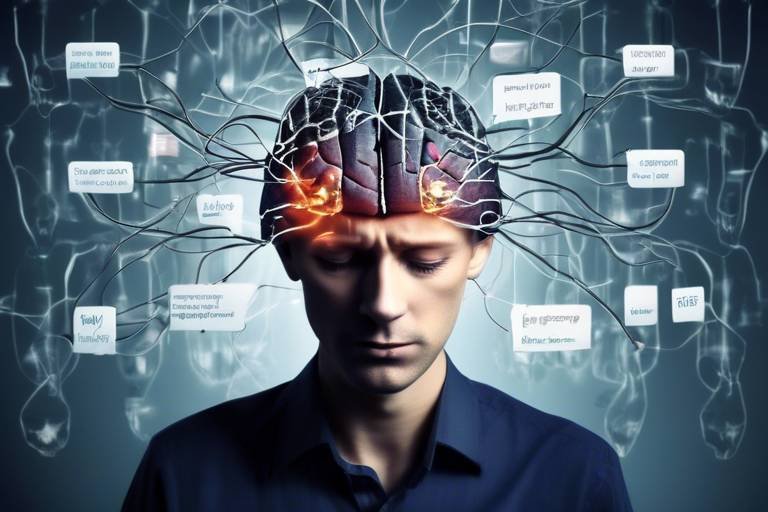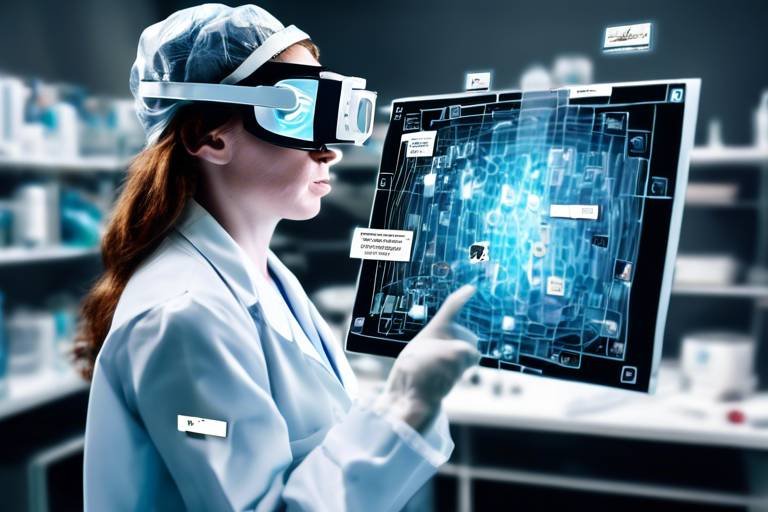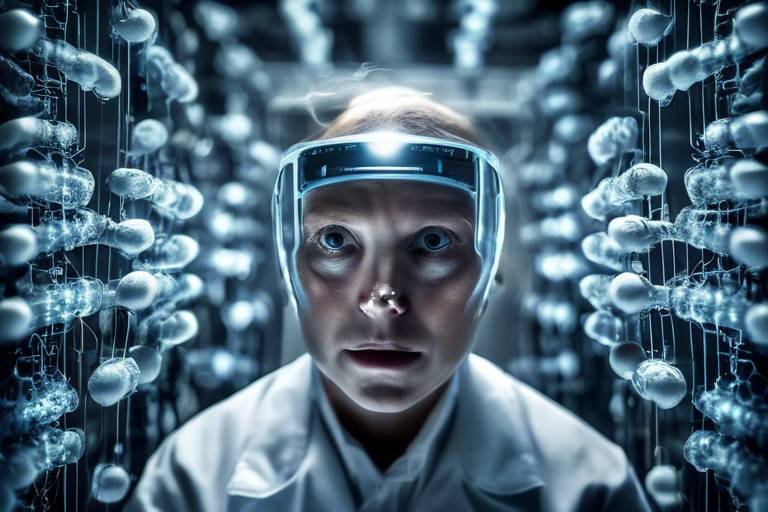How Technology is Enhancing Forensic Science
The world of forensic science is undergoing a remarkable transformation, driven by the relentless march of technology. This evolution is not just a minor upgrade; it’s akin to switching from a flip phone to a smartphone. The integration of cutting-edge tools and techniques is revolutionizing how investigators approach crime scene investigations, analyze evidence, and ultimately solve crimes. Imagine a detective equipped with high-tech gadgets that can analyze DNA in mere hours or reconstruct crime scenes in stunning 3D detail. It’s not science fiction; it’s the reality of modern forensic science.
At the heart of this transformation is the ability to collect, analyze, and interpret data with unprecedented speed and accuracy. Gone are the days of waiting weeks or even months for forensic results. Today, technology enables rapid DNA analysis, sophisticated digital forensics, and even the use of artificial intelligence to sift through mountains of data. This not only enhances the efficiency of investigations but also increases the likelihood of achieving justice for victims and their families. In this article, we will explore some of the most exciting advancements in forensic science that are reshaping the field and making the impossible, possible.
One of the most significant advancements is in DNA analysis. Modern techniques allow forensic scientists to extract and analyze DNA from even the smallest samples. This is particularly crucial for solving cold cases, where evidence might have been overlooked or improperly analyzed in the past. With the advent of rapid DNA testing, law enforcement can now obtain results in a matter of hours rather than weeks, leading to quicker arrests and resolutions. Imagine the relief of a family finally getting closure on a case that has haunted them for years, all thanks to this technological leap.
Moreover, the field of digital forensics has become indispensable in today’s investigations, especially with the prevalence of electronic devices. Investigators can recover and analyze digital evidence from computers, smartphones, and even cloud storage. This includes a variety of data types, from emails and text messages to images and videos, which can be pivotal in building a case. The ability to retrieve deleted files or even access encrypted data has opened new avenues for solving crimes that would have remained unsolved otherwise.
As we delve deeper into the topic, we will also explore the role of artificial intelligence in forensic science. AI technologies are being employed for predictive analytics and pattern recognition, allowing investigators to identify potential suspects or crime trends more effectively. The use of machine learning algorithms is enhancing the efficiency of evidence evaluation, making it easier to sift through vast amounts of data and focus on the most relevant information.
In conclusion, the integration of technology into forensic science is not merely an enhancement; it’s a revolution. It’s changing the landscape of criminal investigations, making them faster, more accurate, and more effective. As we continue to embrace these advancements, the future of forensic science looks promising, with the potential to solve crimes that were once thought to be unsolvable.
- What are the main advancements in forensic science due to technology? Modern advancements include rapid DNA analysis, digital forensics, AI applications, and 3D crime scene reconstruction.
- How does artificial intelligence improve forensic investigations? AI helps in predictive analytics and pattern recognition, enhancing the efficiency of evidence evaluation.
- What role does digital forensics play in modern investigations? Digital forensics allows investigators to recover and analyze evidence from electronic devices, which is crucial in today's tech-driven world.
- Can technology help solve cold cases? Yes, advancements in DNA analysis and digital forensics have led to breakthroughs in many cold cases, providing new leads and evidence.

Advancements in DNA Analysis
Modern technology has significantly transformed the landscape of DNA analysis, making it faster, more accurate, and more accessible than ever before. In the past, obtaining a DNA profile from a crime scene could take weeks or even months, but with the advent of advanced techniques, this process has been streamlined. For instance, next-generation sequencing (NGS) allows forensic scientists to analyze multiple DNA samples simultaneously, drastically reducing the time needed to obtain results. This is particularly crucial in cold cases, where quick analysis can lead to breakthroughs in long-standing investigations.
One of the most exciting advancements is the development of rapid DNA analysis systems, which can produce results in just a few hours. These portable devices are being used not only in laboratories but also at crime scenes, enabling law enforcement to make immediate decisions based on DNA evidence. This technology is especially beneficial in situations where time is of the essence, such as identifying victims or apprehending suspects during ongoing investigations.
Moreover, the accuracy of DNA analysis has improved dramatically due to enhanced bioinformatics tools. These tools allow forensic experts to analyze vast amounts of genetic data to identify patterns and anomalies that may not be visible through traditional methods. As a result, the chances of exonerating the innocent have increased, and wrongful convictions can be corrected more swiftly.
To illustrate the impact of these advancements, consider the following table, which highlights some of the key technologies in modern DNA analysis:
| Technology | Description | Impact |
|---|---|---|
| Next-Generation Sequencing (NGS) | Allows simultaneous analysis of multiple DNA samples. | Faster results, improved cold case resolution. |
| Rapid DNA Analysis | Portable devices that provide results in hours. | Immediate decision-making at crime scenes. |
| Bioinformatics Tools | Analyze large datasets for patterns and anomalies. | Higher accuracy, increased chances of exoneration. |
As we continue to embrace these technological advancements, the implications for forensic science are profound. Not only do they enhance our ability to solve crimes, but they also foster a greater sense of justice by ensuring that the innocent are protected. The future of DNA analysis holds even more promise, with ongoing research aimed at developing even more sophisticated techniques. Imagine a world where DNA evidence could be processed in real-time, leading to instant results that could change the course of an investigation!
In conclusion, the advancements in DNA analysis are not just about technology; they are about the lives impacted by the ability to accurately identify perpetrators and exonerate the wrongly accused. As we move forward, it is essential for forensic scientists, law enforcement, and the public to understand and support these innovations, which ultimately contribute to a safer and more just society.

Digital Forensics Techniques
In today's digital age, the vast majority of our lives are intertwined with technology. From smartphones to laptops, we generate and store an enormous amount of data daily. This is where digital forensics comes into play, acting as the detective of the digital world. The field has become essential in investigations involving electronic devices, providing law enforcement with the tools needed to uncover digital evidence that can make or break a case.
Digital forensics techniques are designed to recover, analyze, and present data from various electronic devices, ensuring that no stone is left unturned in the pursuit of justice. These techniques are not just about finding evidence; they are about piecing together a narrative from the digital breadcrumbs left behind by individuals. Think of it as a digital puzzle where every piece of data is crucial to completing the picture.
One of the most significant advancements in digital forensics is the development of sophisticated tools that allow forensic experts to delve deep into devices. These tools can recover deleted files, analyze system logs, and even extract data from encrypted sources. For instance, consider how a smartphone can hold a treasure trove of information, from text messages to location data. With the right techniques, forensic specialists can uncover vital evidence that may help solve a case.
The evolution of data recovery methods has been nothing short of remarkable. Traditional methods often involved tedious processes that could take hours or even days. However, with the advent of new technologies, forensic experts can now retrieve lost or deleted information with increased speed and accuracy. Techniques such as disk imaging create a complete copy of a storage device, allowing experts to analyze the data without risking damage to the original source.
Moreover, forensic specialists often utilize specialized software that can recover files from damaged or corrupted drives. This software can scan the drive for remnants of deleted files, providing a second chance to recover crucial evidence. The ability to recover data from damaged devices can be a game-changer in investigations, often turning a seemingly hopeless case into a solvable mystery.
As more data moves to the cloud, the field of cloud forensics has emerged as a critical area of focus. Investigating cloud-based evidence presents unique challenges, such as jurisdictional issues and data privacy concerns. However, forensic experts are developing strategies to navigate these complexities. They employ techniques to capture data from cloud storage services, ensuring that vital evidence is not lost in the digital ether.
Cloud forensics involves a meticulous process of identifying, collecting, and analyzing data stored in cloud environments. This can include everything from emails and documents to social media interactions. The challenge lies in ensuring the integrity of the data while adhering to legal standards. As cloud technology continues to evolve, so too will the methods used to investigate it.
In an era where smartphones are ubiquitous, mobile forensics has become a focal point in digital investigations. Extracting data from mobile devices involves a unique set of tools and processes, as these devices often contain a wealth of information about an individual’s activities. From call logs to app data, mobile devices can provide insights that are invaluable in criminal investigations.
Forensic experts use specialized software that can bypass security measures and extract data from locked devices. This process not only involves retrieving data but also ensuring that the evidence remains admissible in court. The ability to recover crucial evidence from mobile devices is a testament to how far digital forensics has come and highlights its importance in modern investigations.
With the rise of digital crimes, cybersecurity has become an integral part of forensic science. By implementing cybersecurity measures, forensic experts can help prevent criminal activities before they occur. This proactive approach involves not only understanding the tactics used by cybercriminals but also developing strategies to thwart these attempts.
Forensic specialists often collaborate with cybersecurity professionals to create comprehensive strategies that protect sensitive data and prevent breaches. By employing techniques such as intrusion detection systems and data encryption, they can safeguard digital environments, ensuring that evidence remains intact and secure.
- What is digital forensics? Digital forensics is the field that focuses on recovering and analyzing data from electronic devices to uncover evidence for investigations.
- How does mobile forensics differ from traditional forensics? Mobile forensics specifically targets data extraction from mobile devices, which requires specialized tools and techniques due to the unique nature of these devices.
- What challenges does cloud forensics face? Cloud forensics encounters challenges such as data privacy concerns, jurisdictional issues, and the need for specialized techniques to capture and analyze cloud-stored data.

Data Recovery Methods
In the ever-evolving landscape of forensic science, have adapted to keep pace with rapidly advancing technology. The ability to retrieve lost or deleted information is crucial for forensic experts, as it can mean the difference between solving a case and letting a criminal slip through the cracks. Imagine sifting through a digital graveyard, where every byte of data could hold the key to justice. This is where modern techniques come into play, transforming the way forensic investigators approach data recovery.
One of the most effective methods employed today is the use of specialized software tools designed to recover deleted files from various storage devices. These tools can scan hard drives, USB drives, and even memory cards, meticulously piecing together fragments of lost information. For instance, tools like EnCase and FTK Imager are commonly used in the field, allowing investigators to create forensic images of devices and analyze them without altering the original data.
Another significant advancement is the capability to perform live data recovery. This method enables forensic experts to recover data from a device that is still operational. By accessing the system's memory while it is running, investigators can uncover valuable information that might otherwise be lost if the device were powered down. This technique is particularly useful in cases involving volatile data, such as chat logs or temporary files, which can disappear once the device is turned off.
Moreover, the rise of solid-state drives (SSDs) has introduced new challenges for data recovery due to their unique architecture. Unlike traditional hard drives, SSDs use a technology called TRIM that can permanently erase data when files are deleted. Forensic experts have developed specialized techniques to counteract this, such as block-level data recovery, which targets the underlying data storage blocks instead of the file system.
In addition to these methods, forensic investigators often utilize hashing algorithms to verify the integrity of recovered data. By generating a unique hash value for files, they can ensure that the information remains unchanged throughout the recovery process. This verification step is crucial in maintaining the chain of custody, which is vital for the admissibility of evidence in court.
As technology continues to advance, the field of data recovery in forensic science is likely to see even more innovative approaches. From leveraging artificial intelligence to enhance data analysis to developing new tools that can handle the complexities of modern storage devices, the future of data recovery methods is bright. The ability to recover critical evidence not only aids in solving crimes but also plays a pivotal role in exonerating the innocent, making these methods indispensable in the pursuit of justice.

Cloud Forensics
As the digital landscape continues to evolve, the migration of data to the cloud has introduced a new frontier in forensic science known as . This field is critical for law enforcement and investigators, as it addresses the unique challenges posed by cloud storage solutions. Unlike traditional data storage, cloud environments are decentralized and often span multiple jurisdictions, making the retrieval of evidence a complex task. Investigators must navigate a labyrinth of data management policies, encryption protocols, and service provider regulations to access crucial information.
One of the primary challenges in cloud forensics is the dynamic nature of data. In cloud environments, data can be altered, deleted, or moved in real-time, which complicates the process of preserving evidence. Forensic experts must employ specialized tools and techniques to create a forensic image of the cloud data, ensuring that any evidence collected is both accurate and admissible in court. This often involves working closely with cloud service providers to obtain the necessary access and permissions.
Moreover, the legal and ethical considerations surrounding cloud forensics cannot be overlooked. Investigators must be aware of the laws governing data privacy and protection in various jurisdictions, as unauthorized access to cloud data can lead to legal repercussions. This is why collaboration with legal experts is essential when conducting cloud-based investigations. To illustrate the importance of these considerations, here’s a breakdown of some key aspects:
| Aspect | Considerations |
|---|---|
| Data Ownership | Who owns the data stored in the cloud? User vs. provider rights. |
| Jurisdiction | Where is the data stored? Which laws apply? |
| Privacy Laws | Compliance with regulations like GDPR or HIPAA. |
| Access Permissions | Obtaining necessary permissions from service providers. |
Additionally, requires a different skill set compared to traditional digital forensics. Investigators must be proficient not only in forensic analysis but also in understanding cloud architectures and the specific technologies employed by different service providers. This knowledge allows them to tailor their investigative strategies effectively. For instance, understanding how data is stored and managed in a specific cloud service can lead to more efficient evidence retrieval.
In summary, cloud forensics is a rapidly growing field that poses unique challenges and opportunities for forensic scientists. As more data moves to the cloud, the importance of mastering these techniques will only increase. By staying informed about the latest advancements and legal frameworks, forensic experts can ensure they are prepared to tackle the complexities of cloud-based investigations.
- What is cloud forensics? Cloud forensics is the application of forensic science to cloud computing environments, focusing on the retrieval and analysis of data stored in the cloud.
- Why is cloud forensics important? As more data is stored in the cloud, being able to access and analyze this data is crucial for solving crimes and conducting investigations.
- What challenges does cloud forensics face? Challenges include data ownership issues, jurisdictional complexities, and the need for collaboration with cloud service providers.
- How do investigators access cloud data? Investigators often need to work with cloud service providers to obtain access permissions and use specialized tools to retrieve data.

Mobile Forensics
In today's world, where smartphones are practically an extension of ourselves, has become an indispensable tool in criminal investigations. The sheer volume of data stored on mobile devices can be staggering, encompassing everything from text messages and photos to location data and app usage. This wealth of information can provide critical insights into a suspect's actions, relationships, and even their whereabouts at the time of a crime.
Mobile forensics involves a variety of techniques and tools designed to extract and analyze data from mobile devices. Forensic experts utilize specialized software and hardware to recover deleted files, analyze call logs, and even access encrypted data. This process is not just about pulling information; it's about ensuring that the evidence is collected in a way that maintains its integrity and can stand up in court. The key steps in mobile forensics typically include:
- Data Acquisition: This involves creating a bit-for-bit copy of the device's data to ensure that the original evidence remains unchanged.
- Data Analysis: Forensic analysts sift through the data to find relevant information, which may include texts, emails, photos, and app data.
- Reporting: Finally, the findings are documented in a comprehensive report that can be used in legal proceedings.
One of the most exciting advancements in mobile forensics is the ability to analyze data from various operating systems, including iOS and Android. Each system has its own unique security features and data storage methods, which means that forensic experts must stay updated on the latest developments and tools. For example, while iOS devices have robust encryption, forensic tools have evolved to bypass these barriers legally and ethically, allowing investigators to access crucial evidence.
Moreover, the rise of cloud storage has added another layer of complexity to mobile forensics. Many users now store their data in the cloud, which means that investigators must also consider how to access and analyze this data. Cloud forensics involves understanding the legal implications of accessing cloud-stored information and the technical challenges that come with it.
As mobile technology continues to evolve, so too will the techniques used in mobile forensics. The integration of artificial intelligence and machine learning is already beginning to shape the future of this field, allowing for faster data analysis and more accurate results. Imagine a world where forensic experts can predict patterns of behavior based on data analysis from mobile devices—this is not just a dream; it's becoming a reality.
In conclusion, mobile forensics is a dynamic and rapidly evolving field that plays a crucial role in modern investigations. As technology advances, so too do the methods and tools available to forensic experts, ensuring that they can keep pace with the ever-changing landscape of digital evidence.
Q1: What is mobile forensics?
Mobile forensics is the process of recovering and analyzing data from mobile devices, such as smartphones and tablets, to gather evidence for investigations.
Q2: Why is mobile forensics important?
Mobile forensics is important because it helps investigators uncover critical information that can lead to solving crimes, understanding criminal behavior, and providing evidence in court.
Q3: What types of data can be recovered through mobile forensics?
Data that can be recovered includes text messages, call logs, photos, videos, app data, and location information.
Q4: How do forensic experts ensure the integrity of the data?
Forensic experts use specific protocols to create a bit-for-bit copy of the device's data, ensuring that the original evidence remains unchanged during the analysis.
Q5: What challenges do forensic experts face in mobile forensics?
Challenges include dealing with encryption, accessing cloud-stored data, and keeping up with the rapid advancements in mobile technology.

Cybersecurity and Crime Prevention
In today's digital landscape, where almost every aspect of our lives is intertwined with technology, cybersecurity has emerged as a critical component in the fight against crime. With the rise of cybercriminal activities, from identity theft to ransomware attacks, forensic science is stepping up to the plate, using advanced techniques to not only investigate these crimes but also to prevent them from occurring in the first place. Imagine a world where the chances of falling victim to cybercrime are significantly reduced due to proactive measures—this is the goal of integrating forensic science with cybersecurity.
One of the key strategies in this integration is the use of predictive analytics. By analyzing patterns and trends in cyber threats, forensic experts can identify potential vulnerabilities and develop strategies to mitigate risks before they escalate into serious incidents. For instance, organizations can implement security measures based on historical data, anticipating where attacks are most likely to occur. This approach not only saves time and resources but also enhances the overall security posture of an organization.
Moreover, the collaboration between cybersecurity professionals and forensic scientists has led to the development of sophisticated tools designed to detect and respond to threats in real time. These tools can monitor network traffic, identify anomalies, and alert investigators to suspicious activities that may indicate a breach. For example, consider the following table that outlines some common cybersecurity tools and their purposes:
| Tool | Purpose |
|---|---|
| Intrusion Detection Systems (IDS) | Monitor network traffic for suspicious activity |
| Firewalls | Control incoming and outgoing network traffic based on security rules |
| Endpoint Protection Platforms (EPP) | Protect endpoints such as computers and mobile devices from threats |
| Security Information and Event Management (SIEM) | Aggregate and analyze security data from across the organization |
Additionally, forensic science plays a vital role in incident response. When a cyber incident occurs, forensic experts are called upon to analyze the breach, recover lost data, and understand how the attack happened. This process not only helps in mitigating the damage but also provides invaluable insights that can be used to strengthen defenses against future attacks. It’s like having a detective on your team who can piece together the puzzle of a crime scene—except in this case, the crime scene is a digital landscape.
Furthermore, the importance of employee training cannot be overstated. Cybersecurity awareness programs are essential in educating personnel about potential threats and safe practices. By fostering a culture of security within organizations, employees become the first line of defense against cybercrime. This proactive approach is akin to teaching a community how to recognize suspicious behavior, ultimately leading to a safer environment for everyone.
In conclusion, the intersection of cybersecurity and forensic science is not just a trend; it's a necessity in our increasingly digital world. By leveraging advanced technologies and methodologies, we can not only respond to cyber incidents more effectively but also prevent them from happening in the first place. The future of crime prevention lies in our ability to adapt and innovate, ensuring that we stay one step ahead of those who seek to exploit our vulnerabilities.
- What role does forensic science play in cybersecurity? Forensic science helps in investigating cyber crimes, recovering data, and understanding attack patterns, which aids in preventing future incidents.
- How can organizations improve their cybersecurity? Organizations can enhance their cybersecurity by implementing advanced tools, conducting regular training for employees, and analyzing historical data for predictive measures.
- What are some common cybersecurity threats? Common threats include phishing attacks, ransomware, malware, and data breaches.

3D Crime Scene Reconstruction
In the realm of forensic science, the advent of has ushered in a new era of investigative capabilities. Imagine stepping into a virtual world where every detail of a crime scene is preserved in stunning clarity. This technology allows forensic experts to create lifelike representations of crime scenes, providing invaluable insights into the dynamics of an incident. By utilizing advanced imaging techniques, such as laser scanning and photogrammetry, investigators can capture a crime scene from multiple angles, ensuring that no detail is overlooked.
These 3D models serve not only as a tool for analysis but also as a powerful means of presenting evidence in court. Jurors and judges can virtually walk through the crime scene, gaining a better understanding of the spatial relationships and events that transpired. This immersive experience can significantly impact their perceptions and decisions. Moreover, the accuracy of these reconstructions helps eliminate ambiguities that often arise from traditional crime scene photographs.
One of the standout features of 3D crime scene reconstruction is its ability to simulate various scenarios. For instance, forensic experts can manipulate the model to recreate different angles of view or to visualize potential actions taken by suspects or victims. This capability not only aids in understanding the sequence of events but also assists in identifying inconsistencies in witness testimonies or suspect alibis.
Furthermore, 3D reconstructions can be integrated with other forensic technologies, such as ballistics analysis and blood spatter interpretation, enhancing the overall investigative process. By layering these analyses onto the 3D model, forensic teams can provide a comprehensive overview of how a crime was committed, which can be crucial in solving cases that have long remained unsolved.
As we look to the future, the potential applications of 3D crime scene reconstruction continue to expand. With ongoing advancements in technology, including virtual reality (VR) and augmented reality (AR), the possibilities are truly exciting. Imagine law enforcement officers using VR headsets to train in simulated crime scenes, honing their skills in a controlled environment before facing real-life situations. This not only prepares them better for their duties but also enhances their ability to gather crucial evidence effectively.
In conclusion, 3D crime scene reconstruction is not just a technological marvel; it is a transformative tool that enhances the effectiveness of forensic investigations. By providing a clear, accurate, and immersive understanding of crime scenes, this technology is paving the way for more efficient and successful investigations, ultimately leading to justice for victims and their families.
- What is 3D crime scene reconstruction?
3D crime scene reconstruction involves creating detailed, lifelike models of crime scenes using advanced imaging techniques to analyze and present evidence. - How does 3D reconstruction help in court?
It provides jurors with an immersive experience, allowing them to understand the crime scene's dynamics and spatial relationships, which can influence their decisions. - Can 3D reconstructions be used for training?
Yes, they can be integrated with virtual reality to train law enforcement officers in handling crime scenes effectively. - What technologies are used in 3D reconstruction?
Techniques such as laser scanning, photogrammetry, and software for modeling and simulation are commonly used.

Virtual Reality Applications
Virtual reality (VR) is not just for gaming anymore; it's making waves in the field of forensic science too! Imagine stepping into a crime scene without leaving your office. The ability to recreate a crime scene in a virtual environment allows investigators to analyze evidence from every angle, making it easier to understand the dynamics of what happened. This immersive technology is a game-changer, providing a level of detail that traditional methods simply cannot match.
One of the most significant benefits of VR in forensic investigations is the ability to visualize complex scenarios. For instance, if a crime occurred in a dimly lit alley, VR can simulate lighting conditions and spatial relationships, giving investigators a clearer picture of how the crime unfolded. This is crucial not only for solving cases but also for presenting evidence in court. A jury can better grasp the events through a realistic simulation than through traditional photographs or diagrams.
Moreover, VR applications are being used for training purposes as well. Forensic professionals can engage in simulated crime scene investigations, honing their skills in a risk-free environment. This hands-on training is invaluable as it prepares them for real-world scenarios, where quick thinking and attention to detail can make all the difference. Imagine being able to practice collecting evidence or interviewing witnesses in a fully immersive setting—it's like a boot camp for detectives!
Another fascinating aspect of VR in forensic science is its potential for collaboration. Multiple experts can enter the same virtual crime scene from different locations, discussing and analyzing evidence in real-time. This collaborative approach not only speeds up investigations but also encourages diverse perspectives, which can lead to breakthroughs in complex cases.
As we look to the future, the integration of VR technology in forensic science is poised to grow even more. With advancements in hardware and software, we can expect even more realistic simulations and enhanced analytical tools. The question is, how will this technology evolve, and what new possibilities will it unlock? One thing is for sure: virtual reality is here to stay, and its impact on forensic science will only deepen as we continue to explore its capabilities.
- What is virtual reality in forensic science? Virtual reality in forensic science refers to the use of immersive technology to recreate crime scenes for analysis, training, and presentation purposes.
- How does VR help in crime scene investigations? VR allows investigators to visualize crime scenes in detail, analyze evidence from multiple angles, and simulate conditions that may have affected the crime.
- Can VR be used for training forensic professionals? Yes, VR provides a safe and realistic environment for training forensic experts, helping them practice skills without the pressure of real-life situations.
- What are the future prospects of VR in forensic science? The future of VR in forensic science looks promising, with advancements in technology likely to enhance simulations and analytical capabilities further.

Augmented Reality in Investigations
Augmented reality (AR) is not just a buzzword; it's a game-changer in the field of forensic investigations. Imagine being able to overlay digital information onto a physical crime scene, providing investigators with real-time data and insights that could make all the difference in solving a case. This technology enhances how forensic experts visualize and analyze evidence, creating a more interactive and informative environment. With AR, the traditional methods of crime scene analysis are transformed into a dynamic experience where every detail can be scrutinized from multiple angles.
One of the most striking benefits of augmented reality is its ability to present complex data in a way that's easy to understand. For instance, imagine a crime scene where a shooting occurred. With AR, forensic investigators can visualize the trajectory of bullets, the positions of witnesses, and even the potential paths of suspects—all layered over the actual scene. This immersive experience not only aids in understanding the crime dynamics but also serves as a powerful tool when presenting evidence in court. Jurors can see the scene as it was, with all the relevant information right before their eyes, making it easier to grasp the facts of the case.
Furthermore, AR can assist in training new forensic professionals. By simulating real-life scenarios, trainees can practice their skills in a controlled environment without the pressure of an actual investigation. This hands-on experience can significantly enhance learning outcomes, ensuring that the next generation of forensic experts is well-prepared to tackle the challenges they will face.
However, it's essential to consider the challenges that come with integrating augmented reality into forensic investigations. The technology requires a robust infrastructure and skilled personnel to manage it effectively. Additionally, there are concerns about data privacy and the potential for misuse of such powerful tools. As AR continues to evolve, it's crucial for law enforcement agencies to establish guidelines and protocols that ensure ethical use and maintain public trust.
In conclusion, augmented reality is revolutionizing forensic investigations by providing a new lens through which to view crime scenes and evidence. Its ability to enhance situational awareness and improve understanding among investigators and jurors alike marks a significant leap forward in the pursuit of justice. As technology continues to advance, we can expect even more innovative applications of AR in forensic science, potentially leading to faster and more accurate resolutions of criminal cases.
- What is augmented reality in forensic investigations?
Augmented reality in forensic investigations refers to the use of digital overlays on physical crime scenes to provide real-time information and insights, enhancing the analysis and understanding of evidence.
- How does AR improve crime scene analysis?
AR improves crime scene analysis by allowing investigators to visualize complex data, such as bullet trajectories and witness positions, directly on the scene, making it easier to comprehend the dynamics of the crime.
- Can AR be used for training forensic professionals?
Yes, AR can simulate real-life scenarios for training purposes, helping new forensic professionals practice their skills in a controlled and immersive environment.
- What are the challenges of using AR in investigations?
Challenges include the need for a robust infrastructure, skilled personnel, and concerns regarding data privacy and ethical use of the technology.

Artificial Intelligence in Forensics
Artificial Intelligence (AI) is rapidly transforming the landscape of forensic science, making it more efficient and effective than ever before. The integration of AI technologies into forensic investigations is akin to giving detectives a powerful magnifying glass that not only enhances their vision but also helps them see connections and patterns that would otherwise remain hidden. With the sheer volume of data generated in today’s digital age, traditional methods of analysis can be time-consuming and prone to human error. However, AI is stepping in to streamline these processes, allowing forensic experts to focus on solving cases rather than getting bogged down by tedious data sifting.
One of the most significant contributions of AI in forensics is its ability to perform predictive analytics. This involves using algorithms to analyze historical data and identify trends that can inform future investigations. For example, AI can recognize patterns in criminal behavior, which can help law enforcement agencies anticipate where crimes are likely to occur and deploy resources accordingly. Imagine having a tool that can predict hotspots for criminal activity based on past data—this is not just a fantasy but a reality thanks to AI.
Another area where AI shines is in pattern recognition. Forensic experts often deal with vast amounts of evidence, from fingerprints to digital footprints. AI algorithms can analyze these datasets at lightning speed, identifying similarities and discrepancies that might take human analysts days or even weeks to uncover. This capability not only speeds up investigations but also increases the accuracy of evidence evaluation. For instance, in cases of fraud, AI can quickly sift through transactions to identify anomalies that warrant further investigation, saving valuable time and resources.
However, the use of AI in forensics is not without its challenges. Ethical considerations loom large, particularly regarding privacy and the potential for bias in AI algorithms. For example, facial recognition technology, a subset of AI, has come under scrutiny for its accuracy and the risk of misidentifying individuals, particularly among minority groups. As such, it is crucial that forensic scientists and law enforcement agencies approach the implementation of AI with a strong ethical framework to ensure that these powerful tools are used responsibly.
To illustrate the impact of AI in forensic science, consider the following table that summarizes some key AI applications and their benefits:
| AI Application | Benefits |
|---|---|
| Predictive Analytics | Identifies crime trends and hotspots, enhancing resource allocation. |
| Pattern Recognition | Speeds up evidence analysis, increasing accuracy and efficiency. |
| Facial Recognition | Aids in suspect identification, though ethical concerns must be addressed. |
| Data Mining | Uncovers hidden connections in large datasets, facilitating investigations. |
In conclusion, the integration of Artificial Intelligence into forensic science is revolutionizing how investigations are conducted. From predictive analytics to pattern recognition, AI is enhancing the efficiency and accuracy of forensic analyses. However, it is essential to navigate the ethical landscape carefully to ensure that these advancements benefit society as a whole. As we continue to explore the capabilities of AI, the future of forensic science looks promising, with the potential to solve even the most complex cases more effectively than ever before.
Frequently Asked Questions
- How does AI improve forensic investigations?
AI enhances investigations by analyzing large datasets quickly, identifying patterns, and predicting trends that can inform law enforcement strategies. - What are the ethical concerns surrounding AI in forensics?
Concerns include privacy issues, potential biases in algorithms, and the risk of misidentifying individuals, particularly with facial recognition technology. - Can AI completely replace human forensic experts?
No, while AI can assist in data analysis and pattern recognition, human expertise remains crucial for interpreting results and making final judgments in investigations.

Machine Learning Algorithms
In the realm of forensic science, have emerged as a revolutionary tool, transforming the way forensic experts analyze data. These algorithms are designed to learn from and make predictions based on vast amounts of data, thus enhancing the efficiency and accuracy of evidence evaluation. Imagine having a super-intelligent assistant that can sift through mountains of information in mere seconds—this is precisely what machine learning brings to the table.
One of the most significant advantages of machine learning in forensics is its ability to identify patterns that are often invisible to the human eye. For instance, when investigating a series of related crimes, machine learning algorithms can analyze various data points—such as locations, times, and methods of operation—to uncover connections that might not be immediately apparent. This capability can lead to the identification of potential suspects or even the prediction of future crimes, enabling law enforcement to act proactively.
Moreover, machine learning algorithms can be trained on historical data to improve their predictive capabilities. For example, if an algorithm is fed data from past criminal cases, it can learn which factors are most indicative of certain types of crime. This is akin to teaching a child to recognize patterns in their environment—over time, they become better at predicting what might happen next based on what they’ve learned. In forensic science, this means more accurate assessments and quicker resolutions to cases.
To illustrate the impact of machine learning in forensic science, consider the following table that highlights some common applications:
| Application | Description | Benefits |
|---|---|---|
| Predictive Policing | Using historical crime data to forecast where crimes are likely to occur. | Reduces crime rates by allowing police to allocate resources more effectively. |
| Pattern Recognition | Identifying trends and patterns in forensic evidence. | Enhances the accuracy of investigations by revealing hidden connections. |
| Facial Recognition | Matching faces from images or videos against a database. | Speeds up suspect identification and helps in locating missing persons. |
While the benefits of machine learning algorithms in forensic science are compelling, it’s also essential to consider the challenges they present. For instance, the accuracy of these algorithms is heavily dependent on the quality of the data fed into them. If the data is biased or incomplete, the outcomes can be misleading. Additionally, ethical concerns arise regarding privacy and the potential for misuse of technology. This is why it’s crucial for forensic professionals to strike a balance between leveraging these advanced tools and maintaining ethical standards in their applications.
In conclusion, machine learning algorithms are not just a passing trend; they are a fundamental shift in how forensic science operates. By harnessing the power of these algorithms, forensic experts can enhance their investigative capabilities, making it easier to solve crimes and bring justice to victims. As technology continues to evolve, we can only expect these algorithms to become even more sophisticated, further revolutionizing the field of forensic science.
- What is machine learning in forensic science? Machine learning in forensic science refers to the use of algorithms that can learn from data to improve the analysis and interpretation of evidence.
- How does machine learning help in solving crimes? By identifying patterns and making predictions based on historical data, machine learning can assist investigators in uncovering connections between cases and predicting potential criminal activity.
- Are there any ethical concerns with using machine learning in forensics? Yes, there are concerns about data privacy, potential biases in algorithms, and the misuse of technology, which necessitate careful consideration and regulation.

Facial Recognition Technologies
Facial recognition technologies have taken the world of forensic science by storm, emerging as a powerful tool that aids law enforcement in identifying suspects with unprecedented speed and accuracy. Imagine a scenario where a crime occurs, and within moments, investigators can scan through thousands of images in a database to find a match. This is not the stuff of science fiction; it's the reality of modern forensic investigations. However, while these technologies offer remarkable advantages, they also raise important ethical considerations that must be addressed.
At its core, facial recognition technology works by analyzing the unique features of a person's face and comparing them to images stored in databases. This process involves several steps, including:
- Image Capture: A photograph or video of the individual is captured, often from surveillance footage.
- Feature Extraction: The system identifies key facial features such as the distance between the eyes, the shape of the jawline, and the contour of the cheeks.
- Comparison: The extracted features are then compared against a database of known faces to find potential matches.
One of the most significant benefits of facial recognition technology is its ability to enhance the efficiency of investigations. For instance, in a recent case, law enforcement was able to identify a suspect within hours of a robbery, thanks to facial recognition software scanning through a database of known offenders. This not only accelerates the investigative process but also increases the chances of apprehending criminals before they can strike again.
However, the rise of facial recognition technologies is not without its challenges. Ethical concerns surrounding privacy and potential misuse of the technology loom large. Critics argue that the widespread use of facial recognition could lead to unwarranted surveillance and a loss of personal privacy. Moreover, there are questions about the accuracy of these systems, particularly when it comes to recognizing faces from diverse racial and ethnic backgrounds. Studies have shown that some facial recognition systems have higher error rates for people of color, leading to potential biases in law enforcement practices.
To address these concerns, many experts advocate for the establishment of clear regulations governing the use of facial recognition technologies. This includes ensuring transparency in how data is collected and used, as well as implementing robust safeguards to prevent misuse. Additionally, ongoing research is crucial to improve the accuracy of these systems across different demographics, ensuring that they serve as a fair and effective tool in the fight against crime.
As we move forward, the role of facial recognition technologies in forensic science will likely continue to grow. With advancements in artificial intelligence and machine learning, these systems are becoming increasingly sophisticated, providing law enforcement with powerful tools to solve crimes. Nevertheless, it is essential that we navigate this landscape thoughtfully, balancing the benefits of technological innovation with the fundamental rights of individuals.
- What is facial recognition technology? Facial recognition technology is a biometric system that identifies or verifies a person by analyzing their facial features and comparing them to a database of known faces.
- How accurate is facial recognition technology? While many systems boast high accuracy rates, there are concerns about biases in recognition, particularly regarding different racial and ethnic groups. Continuous improvements are being made to enhance accuracy.
- What are the ethical concerns associated with facial recognition? Key concerns include privacy issues, potential misuse for surveillance, and the risk of wrongful identification, especially among marginalized communities.
- How is facial recognition used in law enforcement? Law enforcement agencies utilize facial recognition to identify suspects in criminal investigations, analyze surveillance footage, and enhance overall security measures.
Frequently Asked Questions
- How has technology improved DNA analysis in forensic science?
Technology has revolutionized DNA analysis by introducing faster and more precise methods. Advanced techniques like next-generation sequencing allow forensic scientists to analyze DNA samples with greater accuracy, making it easier to solve cold cases and exonerate the innocent. These advancements not only enhance the reliability of results but also significantly shorten the time needed for analysis.
- What role does digital forensics play in modern investigations?
Digital forensics is crucial in today’s investigations as it involves the recovery and analysis of evidence from electronic devices. This includes everything from computers to smartphones. With the rise of cybercrime, digital forensics helps law enforcement uncover hidden data, track digital footprints, and piece together critical evidence that can lead to solving crimes.
- What are some common data recovery methods used in forensic science?
Forensic experts use various data recovery methods, including file carving, imaging, and using specialized software to retrieve lost or deleted information. These techniques enable investigators to access crucial evidence that may have been thought irretrievable, thus enhancing the overall effectiveness of forensic investigations.
- How does cloud forensics differ from traditional forensics?
Cloud forensics focuses on the challenges of retrieving and analyzing data stored in cloud environments, which can be more complex than traditional forensic methods. Since data in the cloud can be distributed across multiple servers and locations, forensic experts must employ specific strategies to ensure they can access and analyze this evidence effectively.
- What technologies are used in mobile forensics?
Mobile forensics utilizes a range of tools and techniques to extract data from smartphones. This includes software for recovering deleted texts, images, and call logs, as well as hardware solutions for bypassing security features. Given the vast amount of personal data stored on mobile devices, these tools are essential for gathering evidence in investigations.
- How does cybersecurity contribute to crime prevention in forensic science?
Cybersecurity plays a vital role in preventing digital crimes by implementing measures that protect systems and data from unauthorized access. Forensic science applies these cybersecurity strategies to not only investigate crimes after they occur but also to thwart potential criminal activities before they happen, making it an essential aspect of modern law enforcement.
- What benefits does 3D crime scene reconstruction offer?
3D crime scene reconstruction provides detailed visualizations that help investigators understand the dynamics of a crime. This technology allows for a more immersive analysis of the scene, enabling forensic experts to present evidence in a compelling way during court proceedings. It enhances situational awareness and aids in the overall investigative process.
- How is virtual reality used in forensic science?
Virtual reality (VR) is used in forensic science to create immersive training environments for investigators. It allows them to practice crime scene analysis and evidence handling in a controlled setting, improving their skills and preparedness for real-life scenarios. VR technology also helps in visualizing complex crime scenes, making it easier to understand the sequence of events.
- What is the significance of artificial intelligence in forensic investigations?
Artificial intelligence (AI) is a game-changer in forensic science, enabling predictive analytics and pattern recognition that enhance investigative outcomes. By analyzing large datasets quickly and accurately, AI assists forensic scientists in identifying trends and making connections that would be difficult to uncover manually, thus streamlining the investigation process.
- How do machine learning algorithms improve forensic analysis?
Machine learning algorithms improve forensic analysis by automating the evaluation of large volumes of data. These algorithms can identify patterns and anomalies that may indicate criminal activity, allowing forensic experts to focus on the most relevant evidence. This not only increases efficiency but also enhances the accuracy of investigations.
- What ethical considerations are associated with facial recognition technologies in forensics?
The use of facial recognition technologies in forensics raises ethical concerns regarding privacy and potential misuse. While these technologies can aid in identifying suspects, there are worries about false positives and the implications of surveillance. Balancing the benefits of facial recognition with ethical considerations is an ongoing discussion in the field of forensic science.

